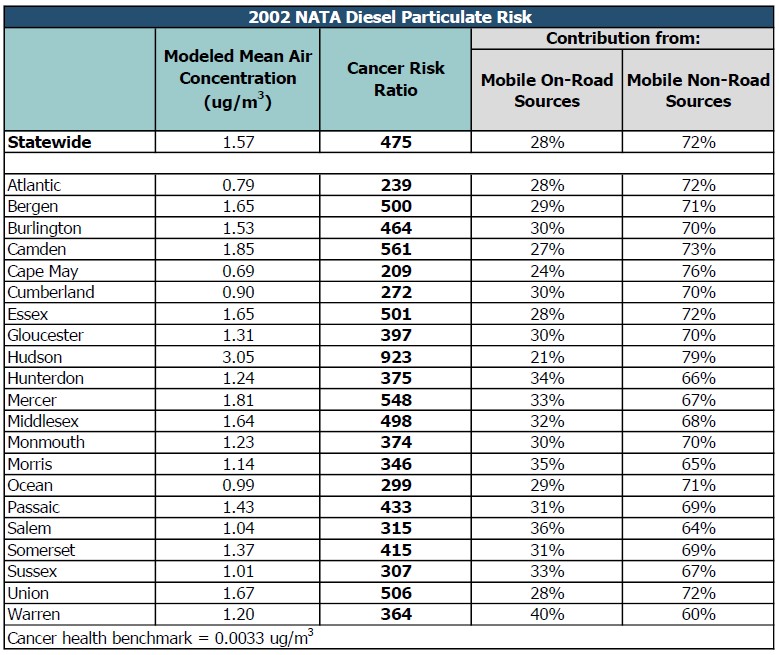Diesel Emissions
Diesel engines emit a complex mixture of air pollutants, composed of both solid and gaseous material. The visible emissions you can see in diesel exhaust are known as particulate matter. These include many carbon particles (also called soot), as well as gases that become visible as they cool. Diesel particulate matter (diesel PM) has been identified as having the potential to cause cancer, as well as many other adverse health effects. In addition to particulate matter, emissions from diesel-fueled engines include over 40 other cancer-causing substances.
The major sources of diesel PM are on-road and off-road vehicles powered by diesel engines. In addition to cars, trucks, and buses, diesel engines are used in construction vehicles, agricultural equipment, trains, and marine vessels. Diesel engines are also used to generate electricity on both an emergency and routine basis, and are also found on cranes, drilling equipment, and portable pumps.
There are hundreds of diesel engines in New Jersey (and many more around the country) that are used to produce power for small-scale operations or are kept to generate electricity in an emergency. Emissions from these diesel engines are not accounted for in USEPA’s diesel PM inventory, but these numerous small sources can contribute significant amounts of pollutants to the air that we breathe. As the larger non-emergency engines apply for or renew New Jersey Air Pollution Control Permits, they are being required to include particulate control measures and/or cleaner fuel in their operations.
For more information on what New Jersey is doing to reduce emissions of and exposure to diesel particulate matter, see Stop The Soot.
DIESEL PM HEALTH RISK AND THE 2002 NATA RESULTS
NJDEP evaluated the health risk from diesel PM in ambient air based on concentrations that were estimated by USEPA for the National Air Toxics Assessment (NATA). Throughout the state, the cancer risk from exposure to diesel PM exceeds the one in a million risk level. Average estimated risk ranged from a high of 923 in a million in Hudson County, to a low of 209 in a million in Cape May County. The statewide average risk is 475 in a million.

CARCINOGENICITY OF DIESEL PM
The International Agency for Research on Cancer (IARC) considers diesel engine exhaust to be “probably carcinogenic to humans.”
For more diesel information from IARC click here.
USEPA did not present quantified diesel cancer risk with any of the NATA results because in their “Health Assessment Document for Diesel Engine Exhaust” (May 2002; EPA/600/8-90/057F) they concluded that the available data were not sufficient to develop a confident estimate of cancer potency (i.e., unit risk estimate or URE). However, USEPA acknowledges that: diesel particulate matter is likely to be carcinogenic to humans through inhalation; several human epidemiology studies link increased lung cancer to diesel exhaust; and exposures in several of these epidemiology studies are in the same range as ambient exposures throughout the United States. USEPA also states that “an exploratory risk analysis shows that environmental cancer risks possibly range from 10-5 to nearly 10-3.” If diesel emissions had been factored into USEPA’s latest AirToxScreen cancer risk assessment, they would have contributed the greatest relative cancer risk.
For more diesel information from USEPA, see Diesel Fuel Standards.
In 1990, California identified diesel exhaust as a chemical known to cause cancer under its Proposition 65. In 1998, particulate emissions from diesel-fueled engines was added to the California Air Resources Board list of Toxic Air Contaminants. California’s Office of Environmental Health Hazard Assessment (OEHHA) subsequently developed a unit risk factor for use in quantifying cancer risk for its Air Toxics Hot Spots Program. The OEHHA “Technical Support Document for Describing Available Cancer Potency Factors” (see below), gives an estimated range of lung cancer risk of 1.3 x 10-4 to 1.5 x 10-3 per ug/m3, with a “reasonable estimate” of 3 x 10-4.” This “reasonable estimate” unit risk factor is used by NJDEP to estimate cancer risk for diesel PM from the NATA. In the table above, it has been converted to a “Cancer Health Benchmark” that is equal to the air concentration that gives a one in a million cancer risk (0.0033 ug/m3).
For more diesel information from California, see: California’s Diesel web page